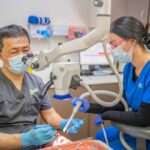Everything You Need To Know About Dental X-Rays
A dental x-ray is a diagnostic tool that we use primarily for the prevention of dental problems, such as decay. For that reason, they’re done at a patient’s active maintenance dental check-up every couple of years unless otherwise needed. X-rays pick up on problems early, especially between teeth that even the best dental eyes can’t see.
This is a useful article if you are worried about dental x-ray effects.
Did you know that digital dental x-rays have the same amount of radiation as a short plane flight (1-2 hours)? That’s Brisbane to Sydney!
If we find decay, x-rays also help us understand how far this decay has progressed, so that we can do the appropriate treatment to prevent any future problems. If we can catch the decay when it’s just at the enamel layer (and not gone deeper into the dentine), then often the patient will only need a filling.
Are Dental X-rays Required Every Two Years?
Every patient is different, and the frequency might be more regular than this if the patient has a history of frequent decay problems, or is in a high risk for another reason. We don’t like to do unnecessary dental X-rays, so it’s a matter of assessing each patient’s risk of decay and recommending X-ray regularity to match that.
If a patient comes in and they’re in pain, then we’ll need to do an x-ray at that time to best assess the extent of the problem, as well as how many teeth are affected.
Should Patient Be Worried About The Exposure to Radiation with Dental X-Rays?
It doesn’t hurt to be conscious of it, but generally, we consider dental x-rays every couple of years to be a safe amount of radiation.
Modern dental technology has gifted us with digital dental x-rays, which have far less radiation than traditional radiographic X-rays. It’s a good idea for patients to check and ensure that their dentist now uses digital X-rays to minimise the dental x-ray effects.
Do The Latest Digital Dental X-Rays Have Less Radiation Than Traditional Radiographic X-Rays?
Yes, digital dental x-rays emit at least 30% to 40% less radiation, and because the digital dental x-ray machine is like a digital SLR camera, you can get instant images rather than wait for the film to be processed.
While we won’t take x-rays unless we have to, let’s put it into perspective: the radiation from a digital dental x-ray is equivalent to that of a flight from Brisbane to Sydney (between one and two hours). When measured in units, a digital dental x-ray will emit around five units, while a chest x-ray is 100 – that’s 20 times more! A CT scan is nearly 10,000 units.
At What Age Can Children Have An X-Ray?
Regular dental checks for yourself and your kids can check for any tooth erosion. Digital dental x-ray machine has a setting for adults and kids, so the dosage for children can be reduced. The way we approach the frequency of x-rays for adults applies to children as well. There’s no age a child must be – as long as they can cope with being in the chair and can hold still.
Generally, we take fewer x-rays for kids because nowadays kids’ teeth are a lot better. They don’t get x-rays unless the tooth enamel becomes suspicious or they’re in a risk group for other problems.
Can An X-Ray Show Decay Under A Filling?
Underneath a filling is a susceptible place for people to get decay, as well as in-between teeth. An x-ray is a good tool to see if there’s decay present and whether it’s going any further or not. However, you’ll more likely see the decay if it’s a tooth-coloured filling rather than an amalgam filling. Because it’s metal, it can block an x-ray so you can’t really see much.
Will An X-Ray Show If A Patient Has An Infection Or Abscess?
Yes. If you have a tender tooth that possibly has an abscess, a dental X-ray is fundamental in showing us how extensive that is and whether we’ll need to do a root canal treatment to remove the abscess and keep the tooth.
Even if a patient has the symptoms of a chronic infection, sometimes we’ll recommend they have an OPG done, as it may find something that surprises us, like gum disease.
What Is An OPG?
The x-rays we do here in the practice will give us small close-ups of your teeth. But sometimes, this doesn’t give us enough information because we need to see the whole dentition – all your top and bottom teeth, how they’re supported in your jawbones, and your jaw joints (even your sinuses). An OPG or orthopantomogram is a special X-ray that will take a panoramic view of these areas.
We don’t have an OPG machine, so we refer the patient to have it done locally. An OPG gives us the whole picture for people that need dental implants, wisdom teeth extraction or kids having braces. It can also show us how extensive a patient’s gum disease may be, how the teeth are fitting into the jawbones, as well as whether sinus problems will make treatment more complicated.
Is There Anything A Dental X-Ray Won’t Help You Diagnose?
X-rays only show hard tissue, so we can only see the teeth and bone, not inside the pulp of the tooth. They also don’t show anything much when it comes to the gums. You don’t need to take any x-rays to diagnose gingivitis (the initial stage of gum disease) because this infection just won’t show up.
The team of dentists at Alderley Dental don’t like to do unnecessary dental x-rays. However, we may do an OPG if it’s a case of chronic gum disease (periodontitis) because then you can see if it has gone as far as the bone and caused damage.
If An X-Ray Can’t See Inside The Pulp Of A Tooth, How Do You Diagnose The Problem?
If a patient comes in with a toothache that’s been aching for two or three days, most of the time it’s from decay, and an X-ray will show that. But if we don’t find anything and suspect there’s a problem in the pulp – the tooth nerve is dying or is agitated – we may check again in two to three weeks, by which time it will show up on an X-ray as a darker area around the apex or root of the tooth.
What New Technology Is Being Used?
There’s a new type of dental x-ray called a Cone Beam scan or CBCT (Cone Beam Computed Tomography). Basically, it’s a dental CT scanner where a cone-shaped x-ray beam moves around your head taking images. All the data is then put together to make a 3D image, so you can imagine how much more detailed and precise these x-rays can be. However, because it’s a type of CT scan, it produces more radiation than a digital dental x-ray.
We might use a cone beam scan if you’re having dental implants or a root canal treatment, or to assess gum disease. If you need one, we’ll refer you to Tooth Scan.
Will An X-Ray Have Any Effect On A Pregnant Patient?
According to the Australian Dental Association requirement or guideline, during pregnancy, there’s no term in which you can’t do an x-ray at all. In the first three months, we may take more precautions – we tend only to do diagnostic x-rays, not ones for preventive reasons. It’s really the patient who makes the decision.
Due for your next dental check-up? Please book an appointment online or call our office on (07) 3856 2144 today.















